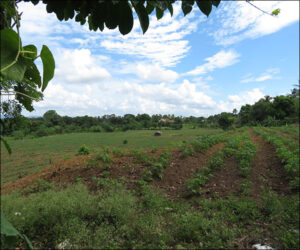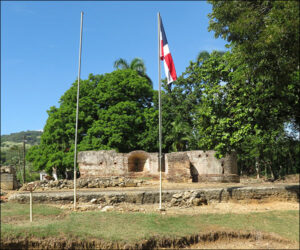Chief Manicoatex burned down the original wooden Fort Concepción at the time of the battle of Santo Cerro (March 1495). The precise site of this original fort is unknown, but it was erected adjacent to Chief Guarionex’s hometown of Guaricano near the base of Santo Cerro by the Verde River, the fort’s water source. The first photo shows a field in that vicinity.

After the battle, Columbus directed that the fort be rebuilt in wood on a bluff nearby, at a site possessing a natural spring. That second construction was completed at the present location of the ruins of a subsequent third construction of the fort in brick and stone. The next photo shows the brick and stone ruins.

As depicted in Columbus and Caonabó, in 1495 Columbus envisioned that the rebuilt wooden fort would serve as the main settlement for collecting the Cibao’s gold. Before the battle, he’d relocated Fray Ramón Pané to live near the original fort to instruct Guarionex in Christianity, and Pané remained living there after the reconstruction for that purpose and to continue writing his report on the “Indian’s” religion (see post of November 4, 2022). In 1496, Guarionex rejected Christianity and plotted overthrowing the fort in a rebellion. In 1497, that rebellion ultimately was crushed by Columbus’s brother Bartolomé at the site of the fort.
As the next sequel will depict, in 1498 Guarionex abandoned his tribute obligation and went to live with Ciguayo’s Chief Mayobanex on “Española’s” northern coast, and Mayobanex fought a brief and brutal war against Bartolomé when Bartolomé invaded to apprehend Guarionex. Bartolomé captured both Guarionex and Mayobanex and incarcerated them in the fort’s dungeon. Guarionex would be chained there from 1498–1502, and Mayobanex would die chained there by 1500.
